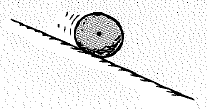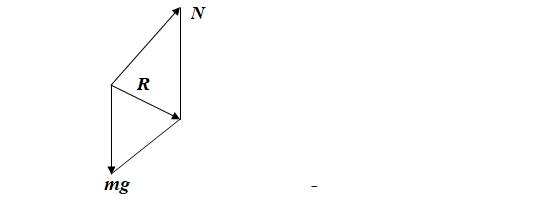
Here is a stone sliding down a friction-free incline.
a. Identify the forces that act on it and draw appropriate force Vectors.
b. By the parallelogram rule, construct the resultant force on the stone (carefully showing it has a direction parallel to the incline—the same direction as the stone’s acceleration).

(a)
The forces that act on the stone and a free body diagram.
Answer to Problem 50A
The forces acts on the stone are weight and normal reaction.
Explanation of Solution
According to the given situation, the force of weight will act in the downward direction and the normal force will be acting perpendicular to the stone’s motion.
Free body diagram:

Conclusion:
The forces act on the stone is weight and normal reaction.
(b)
Construction of resultant force on the stone.
Answer to Problem 50A
The resultant vector is parallel to the incline as shown in the figure.
Explanation of Solution
Introduction:
According to the parallelogram law of vector addition, the resultant vector is the diagonal of the parallelogram of the vectors.
In the given situation the resultant vector is shown in the given construction and will be parallel to the given incline.
Construction:

Conclusion:
The resultant vector is parallel to the incline as shown in the figure.
Chapter 3 Solutions
EP CONCEPTUAL PHYSICS-ITEXT ACCESS
Additional Science Textbook Solutions
Microbiology: An Introduction
Cosmic Perspective Fundamentals
Anatomy & Physiology (6th Edition)
Human Physiology: An Integrated Approach (8th Edition)
Genetic Analysis: An Integrated Approach (3rd Edition)
Human Anatomy & Physiology (2nd Edition)
- No chatgpt plsarrow_forwardConsider the situation in the figure below; a neutral conducting ball hangs from the ceiling by an insulating string, and a charged insulating rod is going to be placed nearby. A. First, if the rod was not there, what statement best describes the charge distribution of the ball? 1) Since it is a conductor, all the charges are on the outside of the ball. 2) The ball is neutral, so it has no positive or negative charges anywhere. 3) The positive and negative charges are separated from each other, but we don't know what direction the ball is polarized. 4) The positive and negative charges are evenly distributed everywhere in the ball. B. Now, when the rod is moved close to the ball, what happens to the charges on the ball? 1) There is a separation of charges in the ball; the side closer to the rod becomes positively charged, and the opposite side becomes negatively charged. 2) Negative charge is drawn from the ground (via the string), so the ball acquires a net negative charge. 3)…arrow_forwardanswer question 5-9arrow_forward
- AMPS VOLTS OHMS 5) 50 A 110 V 6) .08 A 39 V 7) 0.5 A 60 8) 2.5 A 110 Varrow_forwardThe drawing shows an edge-on view of two planar surfaces that intersect and are mutually perpendicular. Surface (1) has an area of 1.90 m², while surface (2) has an area of 3.90 m². The electric field in the drawing is uniform and has a magnitude of 215 N/C. Find the magnitude of the electric flux through surface (1 and 2 combined) if the angle 8 made between the electric field with surface (2) is 30.0°. Solve in Nm²/C 1 Ө Surface 2 Surface 1arrow_forwardPROBLEM 5 What is the magnitude and direction of the resultant force acting on the connection support shown here? F₁ = 700 lbs F2 = 250 lbs 70° 60° F3 = 700 lbs 45° F4 = 300 lbs 40° Fs = 800 lbs 18° Free Body Diagram F₁ = 700 lbs 70° 250 lbs 60° F3= = 700 lbs 45° F₁ = 300 lbs 40° = Fs 800 lbs 18°arrow_forward
- PROBLEM 3 Cables A and B are Supporting a 185-lb wooden crate. What is the magnitude of the tension force in each cable? A 20° 35° 185 lbsarrow_forwardThe determined Wile E. Coyote is out once more to try to capture the elusive Road Runner of Loony Tunes fame. The coyote is strapped to a rocket, which provide a constant horizontal acceleration of 15.0 m/s2. The coyote starts off at rest 79.2 m from the edge of a cliff at the instant the roadrunner zips by in the direction of the cliff. If the roadrunner moves with constant speed, find the minimum velocity the roadrunner must have to reach the cliff before the coyote. (proper sig fig in answer)arrow_forwardPROBLEM 4 What is the resultant of the force system acting on the connection shown? 25 F₁ = 80 lbs IK 65° F2 = 60 lbsarrow_forward
- Three point-like charges in the attached image are placed at the corners of an equilateral triangle as shown in the figure. Each side of the triangle has a length of 38.0 cm, and the point (C) is located half way between q1 and q3 along the side. Find the magnitude of the electric field at point (C). Let q1 = −2.80 µC, q2 = −3.40 µC, and q3 = −4.50 µC. Thank you.arrow_forwardSTRUCTURES I Homework #1: Force Systems Name: TA: PROBLEM 1 Determine the horizontal and vertical components of the force in the cable shown. PROBLEM 2 The horizontal component of force F is 30 lb. What is the magnitude of force F? 6 10 4 4 F = 600lbs F = ?arrow_forwardThe determined Wile E. Coyote is out once more to try to capture the elusive Road Runner of Loony Tunes fame. The coyote is strapped to a rocket, which provide a constant horizontal acceleration of 15.0 m/s2. The coyote starts off at rest 79.2 m from the edge of a cliff at the instant the roadrunner zips by in the direction of the cliff. If the roadrunner moves with constant speed, find the minimum velocity the roadrunner must have to reach the cliff before the coyote. (proper sig fig)arrow_forward
 College PhysicsPhysicsISBN:9781305952300Author:Raymond A. Serway, Chris VuillePublisher:Cengage Learning
College PhysicsPhysicsISBN:9781305952300Author:Raymond A. Serway, Chris VuillePublisher:Cengage Learning University Physics (14th Edition)PhysicsISBN:9780133969290Author:Hugh D. Young, Roger A. FreedmanPublisher:PEARSON
University Physics (14th Edition)PhysicsISBN:9780133969290Author:Hugh D. Young, Roger A. FreedmanPublisher:PEARSON Introduction To Quantum MechanicsPhysicsISBN:9781107189638Author:Griffiths, David J., Schroeter, Darrell F.Publisher:Cambridge University Press
Introduction To Quantum MechanicsPhysicsISBN:9781107189638Author:Griffiths, David J., Schroeter, Darrell F.Publisher:Cambridge University Press Physics for Scientists and EngineersPhysicsISBN:9781337553278Author:Raymond A. Serway, John W. JewettPublisher:Cengage Learning
Physics for Scientists and EngineersPhysicsISBN:9781337553278Author:Raymond A. Serway, John W. JewettPublisher:Cengage Learning Lecture- Tutorials for Introductory AstronomyPhysicsISBN:9780321820464Author:Edward E. Prather, Tim P. Slater, Jeff P. Adams, Gina BrissendenPublisher:Addison-Wesley
Lecture- Tutorials for Introductory AstronomyPhysicsISBN:9780321820464Author:Edward E. Prather, Tim P. Slater, Jeff P. Adams, Gina BrissendenPublisher:Addison-Wesley College Physics: A Strategic Approach (4th Editio...PhysicsISBN:9780134609034Author:Randall D. Knight (Professor Emeritus), Brian Jones, Stuart FieldPublisher:PEARSON
College Physics: A Strategic Approach (4th Editio...PhysicsISBN:9780134609034Author:Randall D. Knight (Professor Emeritus), Brian Jones, Stuart FieldPublisher:PEARSON





